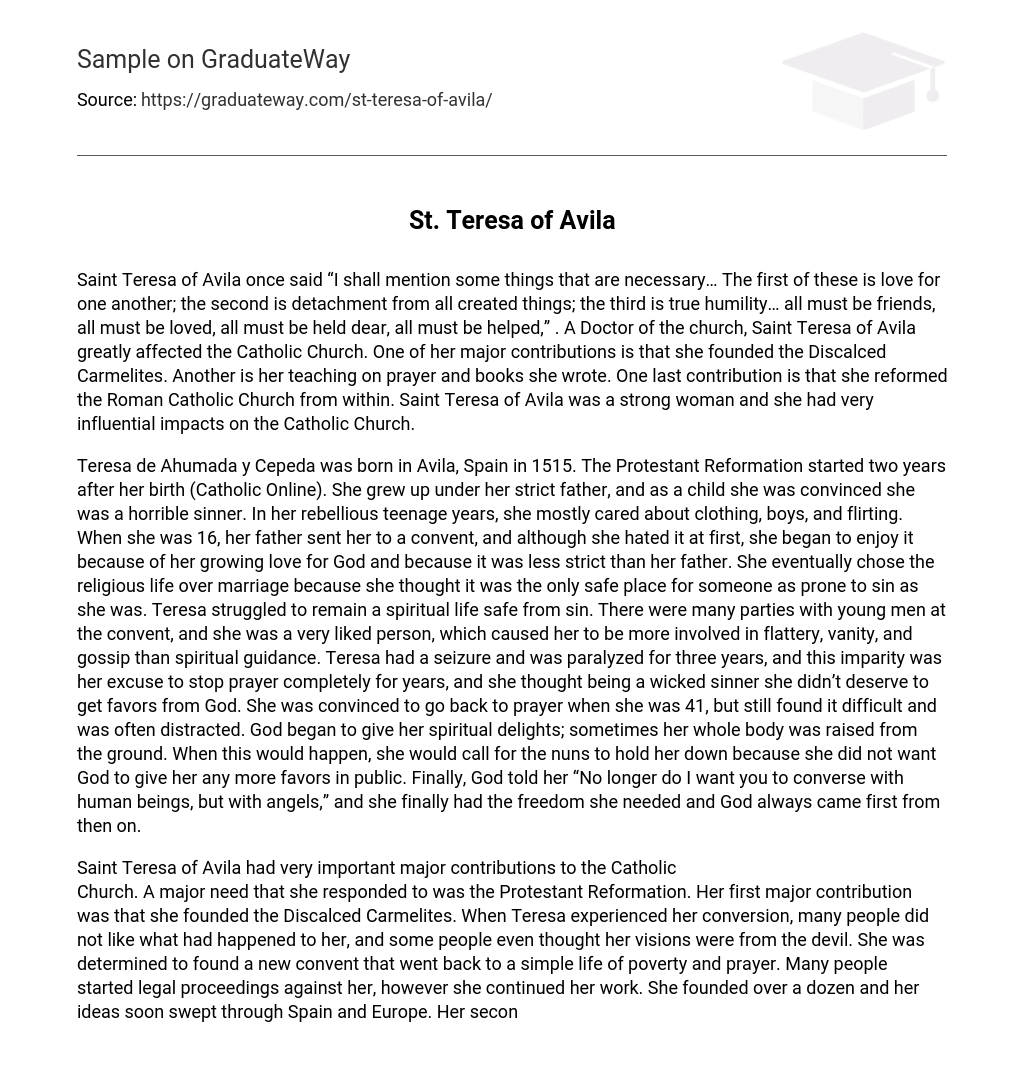“I shall mention some things that are necessary… The first of these is love for one another; the second is detachment from all created things; the third is true humility… all must be friends, all must be loved, all must be held dear, all must be helped,” said Saint Teresa of Avila. A Doctor of the church, she greatly affected the Catholic Church by founding the Discalced Carmelites and teaching on prayer through her books. Furthermore, she reformed the Roman Catholic Church from within. Saint Teresa of Avila was a strong woman who had influential impacts on the Catholic Church.
Teresa de Ahumada y Cepeda was born in Avila, Spain in 1515 during the Protestant Reformation period, as reported by Catholic Online. Raised under strict parenting, Teresa held a strong belief about her own sinful nature since early on. During her rebellious teenage years, she became more focused on clothes, boys, and flirting. At the age of 16, her father decided to send her to a convent. Initially resistant to this idea, Teresa gradually developed an appreciation for the religious life because of her growing love for God and the comparatively relaxed environment at the convent.
Teresa opted for a life dedicated to God instead of marriage due to her belief that it would provide security for someone like herself who had a tendency towards sinfulness. However, maintaining a spiritual life free from sin proved to be challenging for Teresa. Within the social scene of the convent that involved parties with admiring young men, she became more preoccupied with flattery, vanity, and gossip rather than seeking spiritual guidance.
After experiencing a seizure that left her paralyzed for three years, Teresa used this setback as an excuse to completely stop praying. She considered herself unworthy of any blessings from God because she perceived herself as an extremely wicked sinner.At the age of 41, Teresa was finally convinced to resume her prayerful practices. However, she faced challenges in staying focused on spirituality due to distractions. Strikingly, God began giving her spiritual joys and even occasionally lifting her body off the ground. In these moments, Teresa would ask the other nuns to hold her back as she didn’t want any more public displays of God’s favor. Gradually, God directed her to stop talking with humans and instead communicate with angels. This newfound freedom enabled Teresa to prioritize God above everything else.
Saint Teresa of Avila made significant contributions to the Catholic Church. One of her major contributions was the establishment of the Discalced Carmelites, which responded to the need created by the Protestant Reformation. Despite facing opposition and skepticism regarding her visions, Teresa remained determined to create a new convent focused on a simple life of poverty and prayer. Despite legal challenges, she successfully established over a dozen convents, and her ideas quickly spread throughout Spain and Europe. Another major contribution was her spiritual teachings and writings. Through her connection with Christ, she authored four books on prayer and spiritual life: The Book of Her Life, The Way of Perception, The Book of Foundations, and The Interior Castle. These writings possess an inspiring power and strength. Additionally, Teresa reformed the Roman Catholic Church from within and strengthened religious life in Spain, an exceptionally challenging period marked by the Protestant Reformation. Her monasteries became bastions of faith during a time when the Church was being torn apart. Although societal reform was not her intention, the faithfulness to prayer and devotion to God displayed by her nuns led to necessary changes in society (Campbell).Saint Teresa exemplifies the concept of the Church as the Body of Christ. Through her profession of faith and her effort to maintain unity within the Catholic Church amid the Reformation, she assisted in the formation of a community of believers that represents Jesus Christ on earth. She placed great importance on spiritual connection and succeeded in uniting the community in Christ’s divine favor.
Saint Teresa of Avila passed away on October 4, 1582, in Alba De Torres, as she grew weak at an old age. She was beatified in 1614 and then canonized in 1622 by Gregory XV. Her feast day is celebrated on October 15. She is revered as the patron saint for those who suffer from headaches and her symbol consists of a heart, arrow, and book. Furthermore, in 1970, Teresa was granted the title of Doctor of the Church due to her profound writings and teachings on prayer, becoming one of only two women to receive this honor.
Saint Teresa of Avila established the Discalced Carmelites and authored influential books on spiritual faith. She also supported the church amidst the Reformation, making her noteworthy. Personally, I find inspiration in her unwavering commitment to a prayerful life and avoidance of sin, despite facing numerous early challenges. Ultimately, she triumphed over these obstacles and fully embraced a Christ-centered existence with God’s grace. Her contributions to the Church were significant.





